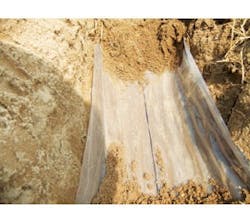About the author: Alvin Smucker is professor of soil biophysics for Michigan State University. Smucker can be reached at [email protected].
Water, the world’s most finite critical resource, ensures economic, environmental, political and social stability. Large cities struggle daily with water quality and related issues while populations increase. Efficient water use is being addressed by industry, urban centers and agriculture. Changing weather patterns, droughts, increasing commodity prices, shortages of high-producing agricultural lands for both food and cellulosic biomass, increasing nitrogen fertilizer costs and low-interest rate loans, combined with growing global demands for food and renewable energy, require a closer evaluation of the merits and demerits of new sustainable technologies that provide the soil, water and nutrient requirements essential for the dramatic expansion of crop production.
Plant water deficits are among the greatest limitations for maximum plant growth potential. Water supply and security, defined as the protection of natural resources and national infrastructures, are facing a global crisis. Growing competition for land that produces food and cellulosic biomass for liquid biofuels continues to require new technologies that eliminate local and regional competitions for water. Retaining soil water by reducing internal percolation losses within the soil profile is becoming a major focus among agricultural scientists and hydrological engineers. Substantial soil water savings can be achieved by storing larger quantities of precipitation and supplemental irrigation in the root zones of plants in a manner that greatly improves plant water use efficiency. The essence of these sustainable plant production technologies is the concept that achieving the most efficient water availability for plants depends on the homogeneous distribution of spatially and temporally distributed water contents within the plant root zone.
Water-Saving Membranes
Michigan State University (MSU) researchers increased corn grain and vegetable production in field tests using a new water-saving membrane technology. A novel subsurface water retention technology (SWRT) dramatically reduced irrigation requirements by retaining at least 50% more soil water in the plant root zone. Water-saving membranes reduced drought stress events even during the driest years. The SWRT water-saving membranes also are designed to prevent flooding in the root zone of sandy soils.
Prescription irrigation of sands is now possible with SWRT water-saving membranes, which have been proven to augment plant biomass production by 150% to nearly 300%. This technology boosts crop yields by increasing shoot-to-root ratios, retaining more soil nutrients, improving soil water use efficiency, increasing soil C sequestration and protecting groundwater. The applicability of SWRT extends to a broad range of agricultural crops, as well as growing cellulosic biomass feedstock on marginal lands.
In the summer of 2012, trials on irrigated sands near Benton Harbor, Mich., SWRT-improved sands produced 145% more (640 cwt per acre) cucumbers than did the control fields (440 cwt per acre) without water-saving membranes.
MSU scientists and engineers also increased corn grain production on SWRT-improved sands near East Lansing, Mich. In the summer of 2012, irrigated corn grain yields increased 135% (213 vs. 158 bushels per acre for controls) on conventional 30-in. row spacings and 174% (268 vs. 154 bushels per acre for controls) on more narrow 15-in. row spacings. These augmented production results have established a precedent for converting marginal and sandy soils into agriculturally productive lands where large quantities of cellulosic biomass, e.g., Miscanthus and switchgrass, can be produced and transported to nearby biorefineries for conversion into ethanol and diesel fuels.
Soil scientists and mechanical engineers at MSU have developed and commercialized a patented membrane installation implement that strategically inserts water-saving membranes, which conserve up to 240,000 gal of irrigation water per acre per year and double the soil water-holding capacity in the plant root zone. SWRT technology has been improved to maintain volumetric soil water contents in the root zone of plants at 18% to 22%, while adjacent replicated control sand water contents drained to field capacity levels of 6% to 11%. This technology offers boosts in crop yields, providing farmers with additional profits while increasing carbon sequestration by the soil, retaining soil nutrients and pesticides in a manner that protects groundwater quality by increasing the bioremediation of soil contaminants.
Long-Term Potential
There now is a long-term technology that controls optimal quantities of soil water, one of the world’s most finite critical resources. These subsurface water retention technologies need additional innovation to increase water use efficiency for maximum plant growth and reduce deep leaching of plant nutrients, toxins and salts on large and small farms in most arid and semiarid regions. Large lawns such as parks, golf courses and sport areas need much more water conservation. The commercialization potential for SWRT is high.
Download: Here
